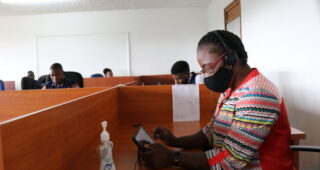Disruptions in Health Services Delivery in Kenya and Cameroon Due to Infection Prevention and Control Limitations in the Context of COVID-19
Overview
Introduction
The SARS-CoV-2 pandemic is disrupting health services worldwide though the reasons behind the disruptions are not fully known. Infection prevention and control (IPC) strives to ensure that healthcare workers (HCWs) and patients are not exposed to or acquire infectious diseases during healthcare. At the beginning of the pandemic, there were multiple reports of HCWs and patients being exposed to COVID-19 in healthcare facilities, due to lack of IPC, resulting in serious illness or death and also in disruptions to healthcare services. Identifying gaps in IPC implementation that have led to the disruption of health care, including resources, personnel, or policies, will be critical in developing more effective IPC protocols and trainings, and facilitating access to supplies and/or trained professionals.
Objectives
To determine the amount, types, and duration of health service disruptions in health facilities in Cameroon and Kenya from March 2020 – February 2021; and the extent to which gaps or limitations in IPC led to health service reductions and/or changes in facility attendance trends in key service delivery areas in the context of the SARS-CoV-2 pandemic.
Methods
This study consisted of a desk review of country SARS-CoV-2-related policies and procedures (including for IPC), cross-sectional surveys of potential health service disruptions in selected health facilities, and an analysis of routine service attendance trends over time in the selected facilities. In each country (Cameroon and Kenya), three regions/counties with high COVID-19 prevalence were selected. Hospitals included in the study were purposively selected. A supplemental random selection of lower-level health facilities was also included. A total of 60 health facilities per country (20 per region/county) were surveyed.
Results
Nearly all health facilities experienced service disruptions across all health service delivery areas. Disruptions were associated with limited patient volumes, service staff reductions, and services suspended or reduced. Noncommunicable disease and antenatal care service attendances were particularly disrupted by the coronavirus pandemic in Cameroon. The severity of the disruptions was low-to-moderate in Kenya, while in Cameroon, they tended to be more severe. Severity was associated with reduced staffing and reduction in the scope of services. IPC-directives were often focused on social (physical) distancing and the suspension of services. The implementation of the distancing was the most common IPC reason for service disruption across all health facilities. However, outbreaks of COVID-19 illness among patients and staff, and staff shortages due to the illness or fear of illness, contributed significantly to service disruptions. This was due to the lack of available staff, the time taken to disinfect health facilities, and the need to triage services.
Conclusion
Health services were disrupted in nearly all health facilities because of COVID-19. The disruption affected all major areas of health service delivery. Investment in IPC resources, personnel, policies, education, and infrastructure is key to reducing and mitigating the impact of the SARS-CoV-2 pandemic on health services. Protection of health staff through vaccination, availability of PPE, screening, isolation of infected staff, and training, should be prioritized. Plans should be developed for a rapid response to COVID-19-like emergencies, with rapid deployment of human, fiscal and material resources, and an emphasis on resilient systems.
Kenya; Cameroon
COVID-19; Research



